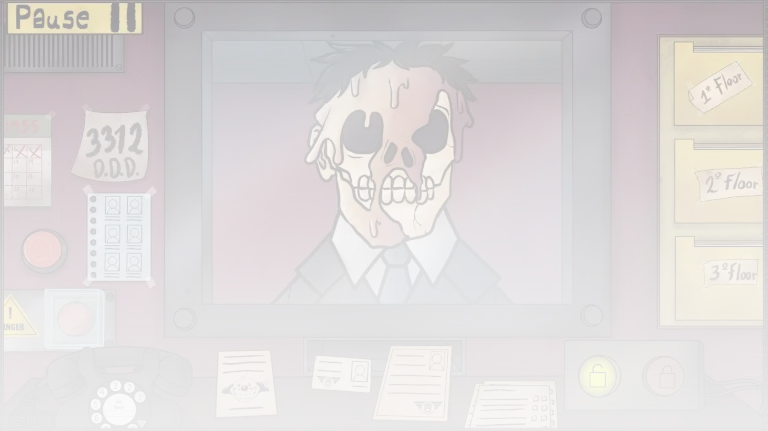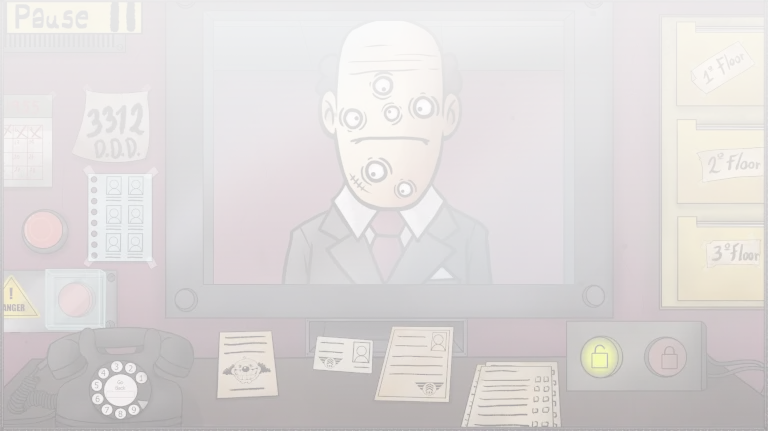
Best Games
Favourite Games
New Games

That’s not my Neighbor
In the unusual world of That’s not my Neighbor, players are transported back to 1955, taking on the role of a doorman in a creepy building inhabited by doppelgangers. This is no ordinary doorman’s job; it’s a crucial line of defense against creatures seeking to enter and disturb the peace of unsuspecting residents. In a setting that perfectly blends nostalgia and a hint of supernatural tension, the game requires keen observation and quick decision-making. Each person standing at the door could either be a real neighbor or a monstrous copycat waiting for a mistake to sneak in. The game brilliantly captures the tension of distinguishing friend from foe, making each moment an exciting test of your detective skills. Here you can read about all endings and all doppelgangers.
The Art of Detection: Unmasking the Imposters
At the heart of That’s Not My Neighbor lies the thrilling task of identifying the doppelgangers among the crowd. These cunning creatures, adept at blending in, challenge players to spot inconsistencies in their appearance or behavior. Some may bear glaring anomalies that scream “imposter,” while others master the art of deception, making the game of cat and mouse all the more exciting. Players must rely on their keen eye for detail to catch these discrepancies, turning the act of gatekeeping into a high-stakes puzzle. The satisfaction of denying entry to a well-disguised doppelganger adds a rewarding layer to the gameplay, emphasizing the critical importance of vigilance in this shadowy showdown.
Critical Examination: Scrutinizing the Evidence
The task of admitting residents goes beyond face value judgments, diving deep into the verification of documents, IDs, and resident lists. In That’s Not My Neighbor, precision is key; every document presented is a piece of the larger puzzle, and any oversight could unwittingly welcome a doppelganger into the fold. Players are equipped with tools and clues to make informed decisions, turning the seemingly mundane task of checking paperwork into an integral part of the game’s suspense. This meticulous process tests players’ attention to detail and cognitive speed, as they sift through information to ensure the safety of the building’s inhabitants.
Support Squad: Summoning the D.D.D.
In moments of uncertainty or danger, players can call upon the D.D.D. for reinforcement. This specialized team, clad in yellow suits, swiftly handles the containment and removal of any identified threats, allowing players to maintain their post with confidence. The D.D.D. serves as both a safety net and an extension of the player’s authority, providing a failsafe for situations that escalate beyond a simple verification. Their presence underscores the game’s dynamic between personal responsibility and collective security, making That’s Not My Neighbor not just a game of individual skill but also a collaborative effort to uphold the sanctity of the community.
Mastering the Gate: Navigating That’s Not My Neighbor
Embarking on the That’s Not My Neighbor journey transforms players into the vigilant gatekeepers of a seemingly mundane apartment block, now the frontline in an unseen war against doppelgangers.
This role goes far beyond the typical day-to-day of a doorman; it’s about peering into the soul of each visitor, discerning truth from deception. The game ingeniously simulates the tension of potential threat with every ring of the doorbell, blending the monotonous with the monumental. Players are tasked with verifying identities, cross-referencing documents, and making the critical call: allow entry or deny access. It’s a delicate balance between ensuring safety and maintaining normalcy, where every decision could tip the scales towards chaos or calm.
How to Play: Tips and tricks
To win in That’s Not My Neighbor, sharp observation and quick thinking are your best allies. Here’s how to sharpen those skills and keep the doppelgangers at bay:
- Detail Dedication: Success in the game hinges on your ability to scrutinize the minutiae. It’s not just about matching faces to photos; it’s about ensuring every detail, from names to identification numbers, aligns perfectly. The more meticulous you are in your inspection, the less likely you are to be deceived by a convincing facade.
- Efficiency is Key: Familiarizing yourself with the game’s interface and mastering the hotkeys can drastically improve your response time. Whether it’s summoning help or verifying information, being able to act swiftly is often the difference between safety and disaster.
- Narrative Discrepancies: Doppelgangers might concoct elaborate stories to explain inconsistencies in their appearance or documentation. Listen carefully and critically evaluate the plausibility of their tales. Often, the devil is in the details, and a story that doesn’t add up can be a red flag.
- Intuition: Sometimes, it’s the undefinable qualities that signal something is amiss. An unusual voice or an awkward demeanor can be indicative of a doppelganger’s poor attempt at mimicry. Trusting your instincts can lead you to re-examine and catch discrepancies you might have overlooked.
- Composure Under Pressure: The true test of a player’s skill is their ability to remain calm and collected in the face of mounting tension. Rushing through verifications increases the likelihood of errors, so it’s crucial to maintain a steady pace, even when the pressure is on.
A Balanced View: Dissecting Game Dynamics
Navigating through the world of That’s Not My Neighbor reveals a multifaceted gaming experience that beckons players with its unique blend of strategy, suspense, and historical ambiance. This game, setting players against a backdrop of duplicity and danger, offers more than just the adrenaline rush of identifying malevolent doubles; it provides a cerebral challenge that demands keen observation and quick thinking. As players stand guard over an apartment complex teeming with potential threats, they engage in a high-stakes game of wits, where the only defense against disaster is their vigilance and judgment.
The Highlights:
· Engaging Complexity: Unlike many horror games that rely on sudden shocks, That’s Not My Neighbor captivates with its psychological tension and the mental gymnastics required to distinguish friend from foe.
· Cognitive Challenge: The game doubles as a brain teaser, pushing players to match faces with documents, remember resident stories, and spot inconsistencies—a true test of memory and attention to detail.
· Aesthetic Charm: With its 1955 setting, the game immerses players in a beautifully crafted vintage environment, enhanced by a soundtrack that’s both evocative and enchanting.
· Rescue Squad: The introduction of the Doppelganger Detection Department (D.D.D.) adds a thrilling dimension to gameplay, providing a lifeline in moments of overwhelming danger.
Areas for Improvement:
· Daunting for Beginners: First-timers may find themselves overwhelmed by the game’s pace and complexity, struggling to keep up with its demanding gameplay.
· Visual Simplicity: The game’s graphics are functional but lack the sophistication of more visually stunning titles, which might detract from the overall experience for some.
· Unforgiving Consequences: A single slip-up can end the game abruptly, with no option for redemption except restarting, a feature that might frustrate players seeking a more forgiving challenge.
· Familiar Territory: Those well-acquainted with ID-checking simulations may find “That’s Not My Neighbor” reminiscent of other titles in the genre, lacking in novelty.
Discuss That’s not my Neighbor





















Лучшая игра в мире!
КЛАСС
csdsd